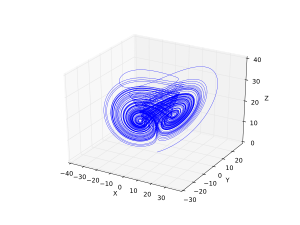
In the mathematics of dynamical systems, the double-scroll attractor (sometimes known as Chua's attractor) is a strange attractor observed from a physical electronic chaotic circuit (generally, Chua's circuit) with a single nonlinear resistor (see Chua's diode). The double-scroll system is often described by a system of three nonlinear ordinary differential equations and a 3-segment piecewise-linear equation (see Chua's equations). This makes the system easily simulated numerically and easily manifested physically due to Chua's circuits' simple design.
Using a Chua's circuit, this shape is viewed on an oscilloscope using the X, Y, and Z output signals of the circuit. This chaotic attractor is known as the double scroll because of its shape in three-dimensional space, which is similar to two saturn-like rings connected by swirling lines.
The attractor was first observed in simulations, then realized physically after Leon Chua invented the autonomous chaotic circuit which became known as Chua's circuit. The double-scroll attractor from the Chua circuit was rigorously proven to be chaotic through a number of Poincaré return maps of the attractor explicitly derived by way of compositions of the eigenvectors of the 3-dimensional state space.
Numerical analysis of the double-scroll attractor has shown that its geometrical structure is made up of an infinite number of fractal-like layers. Each cross section appears to be a fractal at all scales. Recently, there has also been reported the discovery of hidden attractors within the double scroll.
In 1999 Guanrong Chen (陈关荣) and Ueta proposed another double scroll chaotic attractor, called the Chen system or Chen attractor.
Chen attractor
The Chen system is defined as follows
Plots of Chen attractor can be obtained with the Runge-Kutta method:
parameters: a = 40, c = 28, b = 3
initial conditions: x(0) = -0.1, y(0) = 0.5, z(0) = -0.6
Other attractors
Multiscroll attractors also called n-scroll attractor include the Lu Chen attractor, the modified Chen chaotic attractor, PWL Duffing attractor, Rabinovich Fabrikant attractor, modified Chua chaotic attractor, that is, multiple scrolls in a single attractor.
Lu Chen attractor
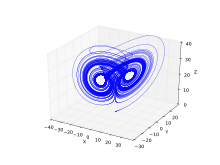
An extended Chen system with multiscroll was proposed by Jinhu Lu (吕金虎) and Guanrong Chen
Lu Chen system equation
parameters:a = 36, c = 20, b = 3, u = -15.15
initial conditions:x(0) = .1, y(0) = .3, z(0) = -.6
Modified Lu Chen attractor
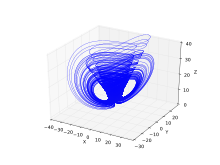
System equations:
In which
params := a = 35, c = 28, b = 3, d0 = 1, d1 = 1, d2 = -20..20, tau = .2
initv := x(0) = 1, y(0) = 1, z(0) = 14
Modified Chua chaotic attractor
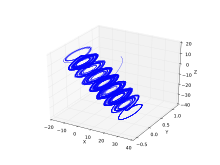
In 2001, Tang et al. proposed a modified Chua chaotic system
In which
params := alpha = 10.82, beta = 14.286, a = 1.3, b = .11, c = 7, d = 0
initv := x(0) = 1, y(0) = 1, z(0) = 0
PWL Duffing chaotic attractor
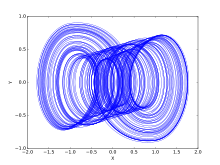
Aziz Alaoui investigated PWL Duffing equation in 2000:
PWL Duffing system:
params := e = .25, gamma = .14+(1/20)i, m0 = -0.845e-1, m1 = .66, omega = 1; c := (.14+(1/20)i),i=-25...25;
initv := x(0) = 0, y(0) = 0;
Modified Lorenz chaotic system
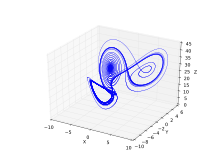
Miranda & Stone proposed a modified Lorenz system:
parameters: a = 10, b = 8/3, c = 137/5;
initial conditions: x(0) = -8, y(0) = 4, z(0) = 10
Gallery
-
 Chen attractor
Chen attractor
-
 parameters a = 35, c = 27, b = 2.8,x(0) = -.1, y(0) = .3, z(0) = -.6
parameters a = 35, c = 27, b = 2.8,x(0) = -.1, y(0) = .3, z(0) = -.6
-
 Lu Chen attractor
Lu Chen attractor
-
 Maple plot of N scroll attractor based on Chen with sine and tau
Maple plot of N scroll attractor based on Chen with sine and tau
-
 9 scroll modified Chua chaotic attractor
9 scroll modified Chua chaotic attractor
-
 xy plot of 9 scroll modified Chua chaotic attractor
xy plot of 9 scroll modified Chua chaotic attractor
-
 PWL Duffing chaotic attractor xy plot
PWL Duffing chaotic attractor xy plot
-
 PWL Duffing chaotic attractor plot
PWL Duffing chaotic attractor plot
-
 modified Lorenz attractor
modified Lorenz attractor
-
 Rabinovich Fabrikant attractor xy plot
Rabinovich Fabrikant attractor xy plot
References
- Matsumoto, Takashi (December 1984). "A Chaotic Attractor from Chua's Circuit" (PDF). IEEE Transactions on Circuits and Systems. CAS-31 (12). IEEE: 1055–1058. doi:10.1109/TCS.1984.1085459.
- Chua, Leon; Motomasa Komoru; Takashi Matsumoto (November 1986). "The Double-Scroll Family" (PDF). IEEE Transactions on Circuits and Systems. CAS-33 (11).
- Chua, Leon (2007). "Chua circuits". Scholarpedia. 2 (10): 1488. Bibcode:2007SchpJ...2.1488C. doi:10.4249/scholarpedia.1488.
- Chua, Leon (2007). "Fractal Geometry of the Double-Scroll Attractor". Scholarpedia. 2 (10): 1488. Bibcode:2007SchpJ...2.1488C. doi:10.4249/scholarpedia.1488.
- Leonov G.A.; Vagaitsev V.I.; Kuznetsov N.V. (2011). "Localization of hidden Chua's attractors" (PDF). Physics Letters A. 375 (23): 2230–2233. Bibcode:2011PhLA..375.2230L. doi:10.1016/j.physleta.2011.04.037.
- Chen G., Ueta T. Yet another chaotic attractor. Journal of Bifurcation and Chaos, 1999 9:1465.
- ^ CHEN, GUANRONG; UETA, TETSUSHI (July 1999). "Yet Another Chaotic Attractor". International Journal of Bifurcation and Chaos. 09 (7): 1465–1466. Bibcode:1999IJBC....9.1465C. doi:10.1142/s0218127499001024. ISSN 0218-1274.
- 阎振亚著 《复杂非线性波的构造性理论及其应用》第17页 SCIENCEP 2007年
- ^ Chen, Guanrong; Jinhu Lu (2006). "Generating Multiscroll Chaotic Attractors: Theories, Methods and Applications" (PDF). International Journal of Bifurcation and Chaos. 16 (4): 775–858. Bibcode:2006IJBC...16..775L. doi:10.1142/s0218127406015179. Retrieved 2012-02-16.
- Chen, Guanrong; Jinhu Lu (2006). "Generating Multiscroll Chaotic Attractors: Theories, Methods and Applications" (PDF). International Journal of Bifurcation and Chaos. 16 (4): 793–794. Bibcode:2006IJBC...16..775L. CiteSeerX 10.1.1.927.4478. doi:10.1142/s0218127406015179. Retrieved 2012-02-16.
- J. Lu, G. Chen p. 837
- J.Liu and G Chen p834
External links
- The double-scroll attractor and Chua's circuit
- Lozi, R.; Pchelintsev, A.N. (2015). "A new reliable numerical method for computing chaotic solutions of dynamical systems: the Chen attractor case". International Journal of Bifurcation and Chaos. 25 (13): 1550187–1550412. Bibcode:2015IJBC...2550187L. doi:10.1142/S0218127415501874. S2CID 12339358.


















